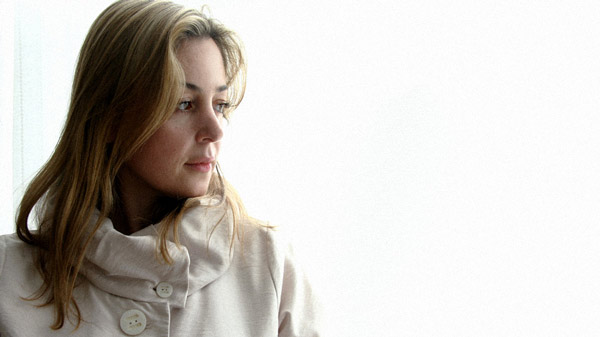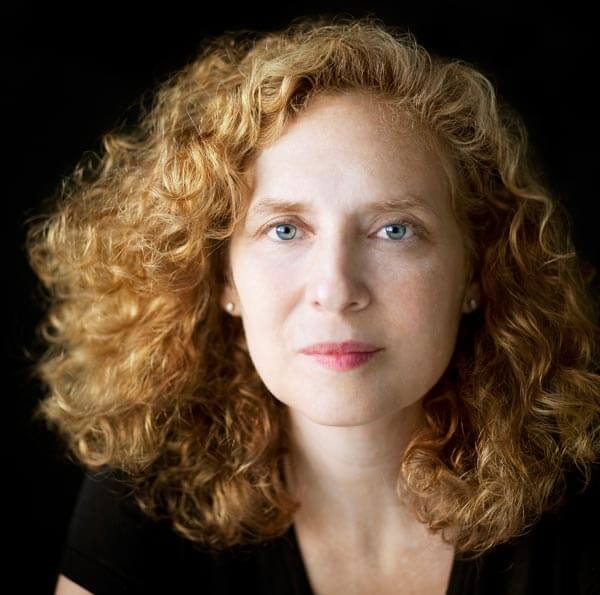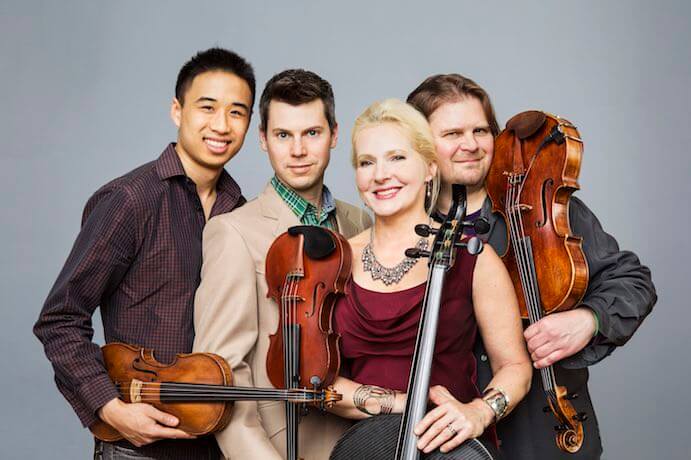On November 4, 2015, the string quartet ETHEL presented a concert at National Sawdust in New York City that showcased women composers. The program included nine women composers who ranged from emerging to established and included the premiere of Julia Wolfe’s Blue Dress for string quartet. Each piece had accompanying projections, designed by Grant McDonald, and displayed on the various panels that make up the wall of National Sawdust.
ETHEL kicked off the evening by performing Chai, a piece by its own cellist, Dorothy Lawson. Chai grooved with bluegrass-infused twangs as violinists shed their more formal role for fiddlers. The gliding bluegrass melodies abounded, showcasing a more relaxed and playful playing style of which ETHEL has previously established themselves as masters. Pamela Z’s ETHEL Dreams of Temporal Disturbances (and wakes up with her head on the TiVo remote) contrasted greatly with Lawson’s piece. Pamela Z, who is mostly known for her solo work as a theatrically and electronically infused vocalist, juxtaposed the string quartet with a pre-recorded electronic track consisting of voices, percussion, and other sounds. The piece manifested itself as disjointed musical episodes framed by the electronic track. Pamela Z’s theatricality found its way through the quartet players at times, such as when they “stabbed” the audience with their bows timed to timpani hits in the final seconds of the piece.
Building off of the theme of recorded voices joining the counterpoint of the string quartet was Lainie Fefferman’s The Pirate’s Daughter. Fefferman’s piece is the ultimate inside joke. Throughout the piece, Fefferman steals music written for ETHEL by other composers verbatim as the members of ETHEL and several composers talk about ETHEL and their favorite pieces in the accompanying pre-recorded track. Fefferman’s ability to piece the works together like a puzzle was astoundingly fun, though it’s anything but accessible, as one who was hearing ETHEL for the first time that night would understand it.

Paola Prestini
Aria by Paola Prestini, one of the founders of National Sawdust, followed. The music is reflexive of the title. Slow moving counterpoint anchored by a simple motif permeated the quartet, and the quartet was, for the first time in the evening, given a chance to really sing. Throughout Aria, ETHEL demonstrated their extreme dexterity, so on-point that one could imagine one was listening to a recording rather than a live performance. ETHEL’s immaculate playing was a theme throughout the entire evening. Contrasting with the meditative quality of Prestini’s piece was Missy Mazzoli’s fast-paced Quartet for Queen Mab. The piece begins with a motif filled with grace notes and embellishment. This first idea grows outward until it fills the accompaniment, though at times the embellishment idea finds its way into the foreground as the accompaniment grounds itself in a groove.
The highlight of ETHEL’s evening of women composers was the premiere of Julia Wolfe’s Blue Dress for string quartet. The piece is based off her earlier work from 2010, With a blue dress on for violin solo and four pre-recorded violins. The piece begins with players humming and playing their instruments in unison, except for a single perfect fifth interval at the re-articulation of the note in the violin. The harmony slowly expands outward, growing in complexity until eventually a groove emerges filled with a folky, bluegrass feel filled with coordinated dissonance. Projections are also present during the piece, showing photos of deforestation and the rise of coal mining communities in the early 20th century. In this piece, the connection to the projections was powerful and clear, unlike some of the other pieces where it seemed projections were chosen for the sake of having projections. Between the music itself and the accompanying projections, it is clear that Blue Dress falls into Wolfe’s oeuvre of pieces related to American folk and coal mining history, which has influenced much of her work over the last several years. Blue Dress soon grows to a climactic clamor, filled with quick fiddle playing, singing, and foot stomping. The only momentary break comes when the players finally fully articulate the phrase they have been working to sing: “Pretty little girl with a blue dress on.” However, immediately after the phrase is sung, the players thrust headfirst back into the incessantly pounding texture that existed before.

Julia Wolfe – Photo by Peter Serling
It was hard for ETHEL to follow-up Blue Dress with anything else, as nothing on the evening could quite compare to Wolfe’s piece, but they persevered with Mary Ellen Childs’s After Dust. Childs’s slow-moving piece was presented with projections of outer space. Melodic fragments emerged and were passed between instruments, and grooves eventually found their way to the foreground of the piece. Sticking with the outer space theme, projections of the sun accompanied Aleksandra Vrebalov’s piece Logbook II. The piece included a subtle pre-recorded electronic track made up of gamelan and cricket sounds, which often fell to the background of the quartet playing, only to make itself known during parts where the quartet momentarily fell silent. Here, the integration between the pre-recorded track and the quartet was remarkable, as in some of the other pieces the presentation was a bit jarring. Last but not least was Anna Clyne’s Roulette. This piece also made use of a pre-recorded track, incorporating the sample of a breath that articulated the start of phrases. The pre-recorded track also contains electronic sounds that would slowly increase in volume only to be interrupted by the quartet.
ETHEL’s program was nothing less than action-packed. Nine stunning women composers were showcased, each piece demonstrating the composers’ unique and individual style. As always, ETHEL’s playing was sublime and was only reinforced by the incredible acoustics of National Sawdust. In addition to my thoughts about the concert itself, this review should serve to strongly urge you to make the pilgrimage to Williamsburg to experience the space for yourself. It will definitely be worth it.






















